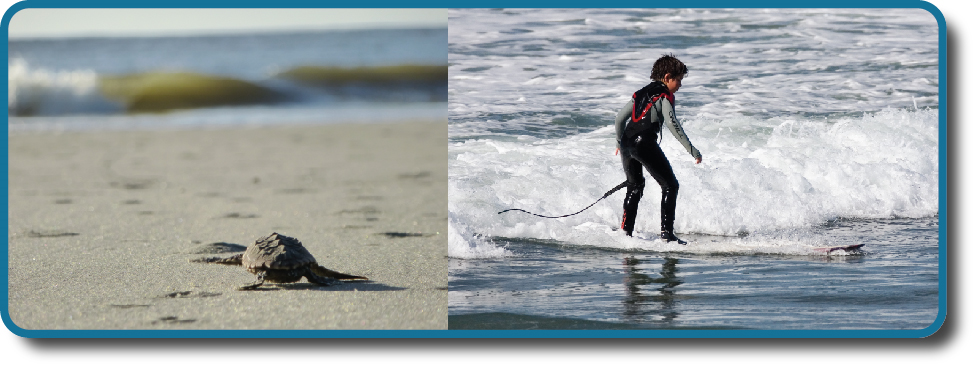6.1 : Prélude à l'apprentissage
- Page ID
- 190547
Objectifs d'apprentissage
- Étudier les principaux modes d'apprentissage
Le soleil d'été brille de mille feux sur une plage déserte. Soudain, une minuscule tête grise émerge du sable, puis une autre et une autre. Bientôt, la plage grouille de nouveau-nés de tortues caouannes (Figure). Bien qu'ils ne soient âgés que de quelques minutes, les nouveau-nés savent exactement quoi faire. Leurs nageoires ne sont pas très efficaces pour se déplacer sur le sable chaud, mais elles continuent leur route, instinctivement. Certains sont rapidement capturés par des goélands qui volent au-dessus de leur tête, tandis que d'autres servent de repas à des crabes fantômes affamés qui sortent de leurs trous. Malgré ces dangers, les nouveau-nés sont poussés à quitter leur nid en toute sécurité et à rejoindre l'océan.

Non loin de cette même plage, Ben et son fils Julian se lancent dans l'océan sur des planches de surf. Une vague approche. Julian s'accroupit sur sa planche, puis saute et surfe sur la vague pendant quelques secondes avant de perdre l'équilibre. Il sort de l'eau à temps pour regarder son père surfer sur la face de la vague.
Contrairement aux bébés tortues de mer, qui savent comment trouver l'océan et nager sans l'aide de leurs parents, nous ne sommes pas nés en sachant nager (ou surfer). Pourtant, nous, les humains, sommes fiers de notre capacité à apprendre. En fait, au fil des milliers d'années et à travers les cultures, nous avons créé des institutions entièrement consacrées à l'apprentissage. Mais vous êtes-vous déjà demandé comment nous apprenons exactement ? Quels sont les processus à l'œuvre lorsque nous apprenons ce que nous savons ? Ce chapitre se concentre sur les principaux modes d'apprentissage.
References
Anderson, C. A., & Gentile, D. A. (2008). Media violence, aggression, and public policy. In E. Borgida & S. Fiske (Eds.), Beyond common sense: Psychological science in the courtroom (p. 322). Malden, MA: Blackwell.
Bandura, A., Ross, D., & Ross, S. A. (1961). Transmission of aggression through imitation of aggressive models. Journal of Abnormal and Social Psychology, 63, 575–582.
Cangi, K., & Daly, M. (2013). The effects of token economies on the occurrence of appropriate and inappropriate behaviors by children with autism in a social skills setting. West Chester University: Journal of Undergraduate Research. Retrieved from www.wcupa.edu/UndergraduateRe...angi_S2012.pdf
Carlson, L., Holscher, C., Shipley, T., & Conroy Dalton, R. (2010). Getting lost in buildings. Current Directions in Psychological Science, 19(5), 284–289.
Cialdini, R. B. (2008). Influence: Science and practice (5th ed.). Boston, MA: Pearson Education.
Chance, P. (2009). Learning and behavior (6th ed.). Belmont, CA: Wadsworth, Cengage Learning.
DeAngelis, T. (2010). ‘Little Albert’ regains his identity. Monitor on Psychology, 41(1), 10.
Franzen, H. (2001, May 24). Gambling, like food and drugs, produces feelings of reward in the brain. Scientific American [online]. Retrieved from www.scientificamerican.com/ar...e-food-and-dru
Fryer, R. G., Jr. (2010, April). Financial incentives and student achievement: Evidence from randomized trials. National Bureau of Economic Research [NBER] Working Paper, No. 15898. Retrieved from http://www.nber.org/papers/w15898
Garcia, J., & Koelling, R. A. (1966). Relation of cue to consequence in avoidance learning. Psychonomic Science, 4, 123–124.
Garcia, J., & Rusiniak, K. W. (1980). What the nose learns from the mouth. In D. Müller-Schwarze & R. M. Silverstein (Eds.), Chemical signals: Vertebrates and aquatic invertebrates (pp. 141–156). New York, NY: Plenum Press.
Gershoff, E. T. (2002). Corporal punishment by parents and associated child behaviors and experiences: A meta-analytic and theoretical review. Psychological Bulletin, 128(4), 539–579. doi:10.1037//0033-2909.128.4.539
Gershoff, E.T., Grogan-Kaylor, A., Lansford, J. E., Chang, L., Zelli, A., Deater-Deckard, K., & Dodge, K. A. (2010). Parent discipline practices in an international sample: Associations with child behaviors and moderation by perceived normativeness. Child Development, 81(2), 487–502.
Hickock, G. (2010). The role of mirror neurons in speech and language processing. Brain and Language, 112, 1–2.
Holmes, S. (1993). Food avoidance in patients undergoing cancer chemotherapy. Support Care Cancer, 1(6), 326–330.
Hunt, M. (2007). The story of psychology. New York, NY: Doubleday.
Huston, A. C., Donnerstein, E., Fairchild, H., Feshbach, N. D., Katz, P. A., Murray, J. P., . . . Zuckerman, D. (1992). Big world, small screen: The role of television in American society. Lincoln, NE: University of Nebraska Press.
Hutton, J. L., Baracos, V. E., & Wismer, W. V. (2007). Chemosensory dysfunction is a primary factor in the evolution of declining nutritional status and quality of life with patients with advanced cancer. Journal of Pain Symptom Management, 33(2), 156–165.
Illinois Institute for Addiction Recovery. (n.d.). WTVP on gambling. Retrieved from http://www.addictionrecov.org/InTheNews/Gambling/
Jacobsen, P. B., Bovbjerg, D. H., Schwartz, M. D., Andrykowski, M. A., Futterman, A. D., Gilewski, T., . . . Redd, W. H. (1993). Formation of food aversions in cancer patients receiving repeated infusions of chemotherapy. Behaviour Research and Therapy, 31(8), 739–748.
Kirsch, SJ (2010). Media and youth: A developmental perspective. Malden MA: Wiley Blackwell.
Lefrançois, G. R. (2012). Theories of human learning: What the professors said (6th ed.). Belmont, CA: Wadsworth, Cengage Learning.
Miller, L. E., Grabell, A., Thomas, A., Bermann, E., & Graham-Bermann, S. A. (2012). The associations between community violence, television violence, intimate partner violence, parent-child aggression, and aggression in sibling relationships of a sample of preschoolers. Psychology of Violence, 2(2), 165–78. doi:10.1037/a0027254
Murrell, A., Christoff, K. & Henning, K. (2007) Characteristics of domestic violence offenders: associations with childhood exposure to violence. Journal of Family Violence, 22(7), 523-532.
Pavlov, I. P. (1927). Conditioned reflexes: An investigation of the physiological activity of the cerebral cortex (G. V. Anrep, Ed. & Trans.). London, UK: Oxford University Press.
Rizzolatti, G., Fadiga, L., Fogassi, L., & Gallese, V. (2002). From mirror neurons to imitation: Facts and speculations. In A. N. Meltzoff & W. Prinz (Eds.), The imitative mind: Development, evolution, and brain bases (pp. 247–66). Cambridge, United Kingdom: Cambridge University Press.
Rizzolatti, G., Fogassi, L., & Gallese, V. (2006, November). Mirrors in the mind. Scientific American [online], pp. 54–61.
Roy, A., Adinoff, B., Roehrich, L., Lamparski, D., Custer, R., Lorenz, V., . . . Linnoila, M. (1988). Pathological gambling: A psychobiological study. Archives of General Psychiatry, 45(4), 369–373. doi:10.1001/archpsyc.1988.01800280085011
Skinner, B. F. (1938). The behavior of organisms: An experimental analysis. New York, NY: Appleton-Century-Crofts.
Skinner, B. F. (1953). Science and human behavior. New York, NY: Macmillan.
Skinner, B. F. (1961). Cumulative record: A selection of papers. New York, NY: Appleton-Century-Crofts.
Skinner’s utopia: Panacea, or path to hell? (1971, September 20). Time [online]. Retrieved from http://www.wou.edu/~girodm/611/Skinner%27s_utopia.pdf
Skolin, I., Wahlin, Y. B., Broman, D. A., Hursti, U-K. K., Larsson, M. V., & Hernell, O. (2006). Altered food intake and taste perception in children with cancer after start of chemotherapy: Perspectives of children, parents and nurses. Supportive Care in Cancer, 14, 369–78.
Thorndike, E. L. (1911). Animal intelligence: An experimental study of the associative processes in animals. Psychological Monographs, 8.
Tolman, E. C., & Honzik, C. H. (1930). Degrees of hunger, reward, and non-reward, and maze performance in rats. University of California Publications in Psychology, 4, 241–256.
Tolman, E. C., Ritchie, B. F., & Kalish, D. (1946). Studies in spatial learning: II. Place learning versus response learning. Journal of Experimental Psychology, 36, 221–229. doi:10.1037/h0060262
Watson, J. B. & Rayner, R. (1920). Conditioned emotional reactions. Journal of Experimental Psychology, 3, 1–14.
Watson, J. B. (1919). Psychology from the standpoint of a behaviorist. Philadelphia, PA: J. B. Lippincott.
Yamamoto, S., Humle, T., & Tanaka, M. (2013). Basis for cumulative cultural evolution in chimpanzees: Social learning of a more efficient tool-use technique. PLoS ONE, 8(1): e55768. doi:10.1371/journal.pone.0055768


